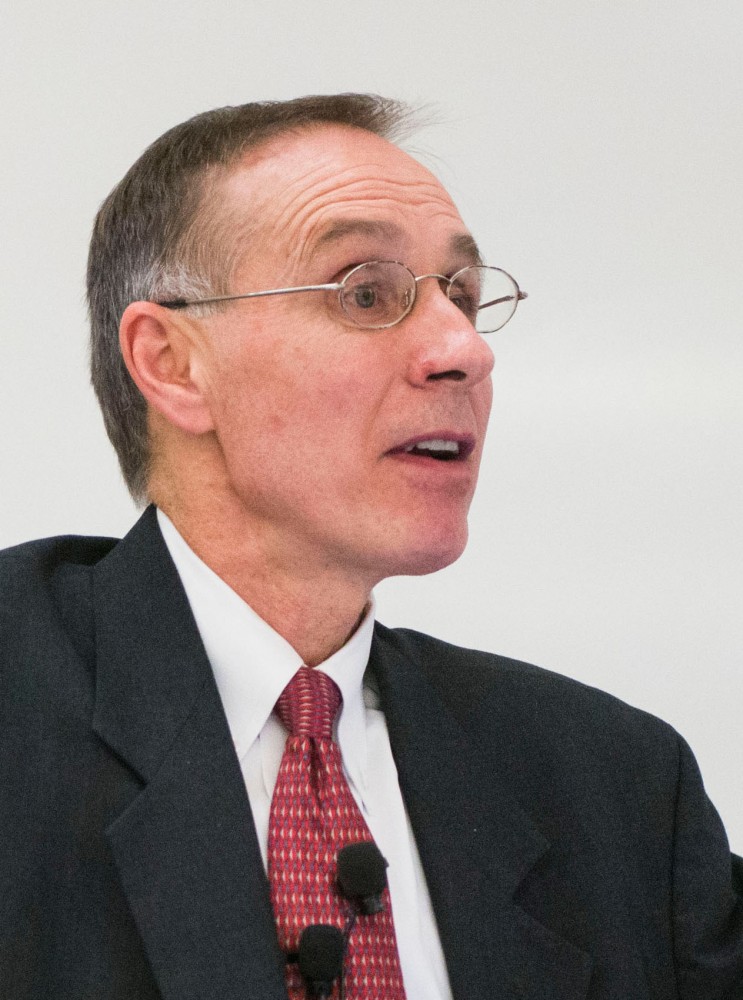In addition to leading one of the largest medical schools in the nation, Brooks Jackson heads half a dozen colleges and seven administrative divisions at the University of Minnesota.
The University’s Academic Health Center has faced criticism for its structure, in which one person leads both the health sciences and the Medical School. But some say Jackson is in a good position to take on the dual role and ultimately boost the University’s reputation as a leader in medicine.
“I think the goal is to literally have a world-class academic health science center, as well as academic health system, that really leads the world in terms of biomedical research, in terms of health care delivery and in terms of education for students,” Jackson said.
He started his new job Monday as dean of the Medical School and vice president for health sciences, replacing Aaron Friedman, who served in the interim role from 2011 to 2014. Former University President Bob Bruininks combined the positions in 2009 to reduce administrative overhead.
As vice president, Jackson oversees the AHC’s six health science colleges: the schools of dentistry, nursing, medicine, pharmacy, public health and veterinary medicine.
University community members have debated for years whether one person can serve both roles effectively and equally, leading to internal and external reviews of the AHC.
One review found that health sciences faculty and staff thought the dual role could be a conflict of interest or “too big for one person,” but they also didn’t offer specific recommendations for how the AHC should be led. A 2011 internal review recommended the roles be split.
In a 2010 survey, almost all of the 354 Medical School faculty members said they would like a dean focused solely on leading their school.
A ‘big, ambitious job’
Despite contention at the University over the dual role, other large health sciences schools in the country — including at least two others in the Big Ten — have a similar structure.
Mark Land, Indiana University associate vice president for public affairs, said the system requires a trusted team of faculty members working under the leader, and when done right, it can be effective.
“If you’ve got good people and you’ve got a good supporting cast … it certainly is doable,” Land said.
Jackson said he plans to have a team he trusts at the Medical School to handle day-to-day activities so he can spend more time on the other health sciences and deal with big-picture issues.
Combining the roles brought structure to Indiana University’s health sciences and attracted higher-quality candidates during the search for a new dean and vice president last year, Land said. The University of Minnesota’s intense search to fill the position began last spring and ended in November.
“By making it a kind of big, ambitious job, you attract big, ambitious people,” Land said.
The University of Michigan functions under a split system in which different people serve as Medical School dean and executive vice president for medical affairs.
Michigan’s Medical School dean, James Woolliscroft, said each university should tailor its structure to its individual needs.
“I don’t see any of these structures as being really superior or inferior,” he said. “It’s how the institution is positioned at that time.”
Woolliscroft, who graduated from the University of Minnesota Medical School in 1976, said the school’s reputation has “slipped” in recent years but he’s glad to see the institution’s leaders pushing to rebuild its national presence. He said the leadership structure isn’t as important as the leader and what he or she can offer.
“The key thing is the person,” Wolliscroft said. “A successful leader is for a time and a place. It depends upon what the greatest needs of the school and the health system are.”
‘Ready to move on’
The AHC is currently in a period of overall transition to secure stability in research, health practices and education, tackle health reform and improve the Medical School by 2025.
Nancy Raymond, associate dean for faculty affairs at the University of Minnesota Medical School, said the school is ready to move forward from past disagreements about structure, and Jackson will help carry out that strategic mission.
“I think those fears have been waylaid, and we’re kind of ready to move on,” she said. “We just need to move forward.”
The AHC is in good standing, and Jackson will continue to move the health sciences in the right direction, his predecessor Friedman said in a statement Friday.
“The external review of the AHC is behind us, allowing us to focus on moving forward together toward shared goals,” he wrote.
Jackson said he’ll focus on collaboration between the schools in the AHC, Fairview Health Services and the University of Minnesota Physicians to bring the University to the top.
“I think each health sciences school has its strengths and weaknesses,” he said. “What’s important is to come together and agree on the way forward with the strategic plan for the whole academic health sciences.”


